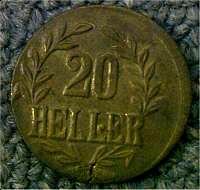 |
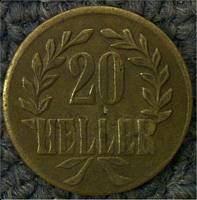 |
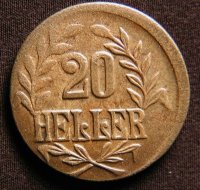 |
Type "A" (Reverse) |
Type "B" (Reverse) |
Type "C" (Reverse) - Rare - |
 |
 |
 |
Type "A" (Reverse) |
Type "B" (Reverse) |
Type "C" (Reverse) - Rare - |
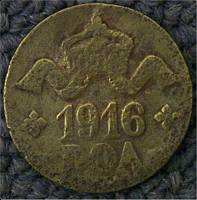 |
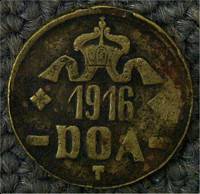 |
There is no type "C" Obverse |
Type "A" (Obverse) |
Type "B" (Obverse) |
These coins were struck while Oberst Paul von Lettow-Vorbeck was busy fending off the attacks of the allies under the famous South African military leader, General Smuts, who led a force of 300,000 soldiers over the mountain slopes of Mt Kilimanjaro (see story below) and rugged African bush. Vorbeck had just a few thousand troops!
There are several varieties of the coin - as seen above - with the
 most obvious differences in the
size of the value and the size of the crown..
most obvious differences in the
size of the value and the size of the crown..
There was a dire shortage of every day items, including brass ingots, so the besieged Germans melted down a 4.1" brass gun taken from the German Cruiser the SMS Konigsberg (image right) that was earlier scuttled in the Rufiji river delta after being sunk by the Allies. A further source of metal was, as described in Intelligence Supplement No. 3 [No.5, No.7, & No.10]-Notes on the Officers Serving With the Enemy Forces in German East Africa by Major R Meinertzhagen (Compiled by the Intelligence Section: General Staff, East African Expeditionary Force, July 14th, 1916), "The New German 20 Heller War Coin made from English Cartridge Cases." A few coins were also struck in copper and bronze. (See images below). These coins were made from scrap copper and brass. Sources include spent cartridges, wiring, home furnishings, and so on. All are crudely struck except for the gold coins which were more carefully designed and produced on a steam-driven palm oil press.
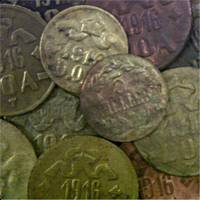 A
rudimentary stamp was used at the Tabora "mint" to produce these coins struck
crudely out of "gun metal" - resulting in a rough finish in even Uncirculated
examples! Although type "B" varierties are not unduly rare and can be purchased
for about US$20, the history and make up of these coins is quite extraordinary.
The type "C" Reverse seen above - is the rarest of the 20 Heller pieces.
There are many books available on the
exploits of the German army under von Lettow-Vorbeck that reflect this remarkable
fact. You can feel it when holding one of the 20 Heller "gun metal"
coins.
A
rudimentary stamp was used at the Tabora "mint" to produce these coins struck
crudely out of "gun metal" - resulting in a rough finish in even Uncirculated
examples! Although type "B" varierties are not unduly rare and can be purchased
for about US$20, the history and make up of these coins is quite extraordinary.
The type "C" Reverse seen above - is the rarest of the 20 Heller pieces.
There are many books available on the
exploits of the German army under von Lettow-Vorbeck that reflect this remarkable
fact. You can feel it when holding one of the 20 Heller "gun metal"
coins.
Some 302,000 of the relatively uncommon 5 Heller "gun metal" coins were manufactured in brass and produced, mostly of the thick, oval-base crown variety.
The 20 Hellers come in copper and brass versions and there
are 2 obverse and 3 reverse designs, all of which occur together in both
medals, although some combinations are quite rare. Altogether, some 325,940
copper and 1,307,760 brass 20 Hellers were made. There are no extant records
of how many were produced of each die type.
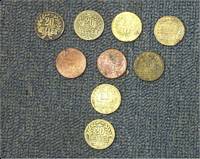 |
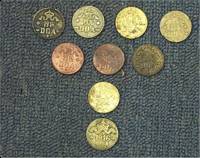 |
See also the 1902 Veld Pond struck by the boers on the run
Value in 2005: The 1916 20 Heller Coin "B' type is common - valued at US$20 in VF+, the "A" variety rarer while the type "C" variety is very rare. The more common 20 Heller coins are frequently seen on auctions like eBay. The 5 Heller coin is more rare and normally sells for over US$30.
[Brief history of German East Africa]
[1915 Interim Bank Notes] [The
20 Heller "gun metal" coin struck in 1916]
[1916 15 Rupee "Tabora Pound" Gold Coin]
[1917 Interim Bank Notes - struck in the field]
[von Lettow-Vorbeck an extraordinary soldier]
[Vorbeck's Despairing Post Card]
[Rare German East Africa Siege Coins, Notes and
Collectables] [Web Site Text Site Map]
[Tokencoins.com Home Page]